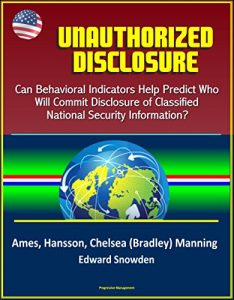This excellent report has been professionally converted for accurate flowing-text e-book format reproduction. Federal government security-cleared personnel have been disclosing federal government classified national security information, whether to a foreign government or the United States media, at an increasing rate since the 1980s. Can common personal or psychological characteristics or motivations be identified from historical cases that could indicate the likelihood of a current or potential federal employee to disclose national security information without authorization? Reasons for unauthorized disclosure range from financial, to "whistle-blowing," to a desire to change international policy, to sympathy and strong ties with a foreign government. The focus of this research is on the behavioral characteristics that are similar or different between known, studied historical cases of personnel associated with the federal government who have disclosed classified information without authorization. Upon review of existing data, the prevalent behavioral characteristic of the cases is one of a disgruntled employee (ideology/ disillusionment/loyalty). A disgruntled employee becomes the largest concern as an insider threat, one who is willing to compromise his or her feelings of loyalty to the organization and the nation for a myriad of reasons.
Why do people disclose information with which they have been entrusted? Reasons for unauthorized disclosure range from financial, to "whistle-blowing," to a desire to change international policy, to sympathy and strong ties with a foreign government. The focus of this research is on the behavioral characteristics that are similar or different between known, studied historical cases of personnel associated with the federal government who have disclosed classified information without authorization. Cases studied include Aldrich Ames, Ana Belen Montes, Chelsea (Bradley) Manning, Brian Regan, Bryan Underwood, Greg William Bergersen, Hassan Abu-Jihaad (Paul R. Hall), Robert Hanssen, John Walker, Jonathon Pollard and Edward Snowden. Selection is based on unauthorized disclosure since the 1980s, including 1985—referred to as the "year of the spy."
Upon review of existing data, the prevalent behavioral characteristic of the cases (10 out of 11 cases) is one of a disgruntled employee (ideology/disillusionment/loyalty). A disgruntled employee becomes the largest concern of insider threat, one who is willing to compromise his or her feelings of loyalty to the organization and the nation for a myriad of reasons. While personal security background investigations review information from the present to up to 10 years prior: Studies of espionage based on personal interviews with offenders suggest a pattern in which personal disruptions or crises precede, or "trigger," an individual's decision to commit espionage. Crises could be positive or negative, and include divorce, death, starting a new relationship, or exhibiting radically changed behavior.
Chapter II provides the literature review conducted for this research. Chapter III provides the history of information classification policy. Chapter IV provides the background of unauthorized disclosure and the "insider threat." Chapter V provides the security clearance process including the 13 adjudicative guidelines. Chapter VI discusses the role of technology in the security clearance process today. Chapter VII provides the biographical sketches of known cases reviewed. Chapter VIII provides a discussion of the gathered data and analysis of the most and least common identifiable personality characteristics of known offenders. Chapter IX provides recommendations, including limitations to eliminating unauthorized disclosure, implementation issues, and opportunity for future research.
Why do people disclose information with which they have been entrusted? Reasons for unauthorized disclosure range from financial, to "whistle-blowing," to a desire to change international policy, to sympathy and strong ties with a foreign government. The focus of this research is on the behavioral characteristics that are similar or different between known, studied historical cases of personnel associated with the federal government who have disclosed classified information without authorization. Cases studied include Aldrich Ames, Ana Belen Montes, Chelsea (Bradley) Manning, Brian Regan, Bryan Underwood, Greg William Bergersen, Hassan Abu-Jihaad (Paul R. Hall), Robert Hanssen, John Walker, Jonathon Pollard and Edward Snowden. Selection is based on unauthorized disclosure since the 1980s, including 1985—referred to as the "year of the spy."
Upon review of existing data, the prevalent behavioral characteristic of the cases (10 out of 11 cases) is one of a disgruntled employee (ideology/disillusionment/loyalty). A disgruntled employee becomes the largest concern of insider threat, one who is willing to compromise his or her feelings of loyalty to the organization and the nation for a myriad of reasons. While personal security background investigations review information from the present to up to 10 years prior: Studies of espionage based on personal interviews with offenders suggest a pattern in which personal disruptions or crises precede, or "trigger," an individual's decision to commit espionage. Crises could be positive or negative, and include divorce, death, starting a new relationship, or exhibiting radically changed behavior.
Chapter II provides the literature review conducted for this research. Chapter III provides the history of information classification policy. Chapter IV provides the background of unauthorized disclosure and the "insider threat." Chapter V provides the security clearance process including the 13 adjudicative guidelines. Chapter VI discusses the role of technology in the security clearance process today. Chapter VII provides the biographical sketches of known cases reviewed. Chapter VIII provides a discussion of the gathered data and analysis of the most and least common identifiable personality characteristics of known offenders. Chapter IX provides recommendations, including limitations to eliminating unauthorized disclosure, implementation issues, and opportunity for future research.












